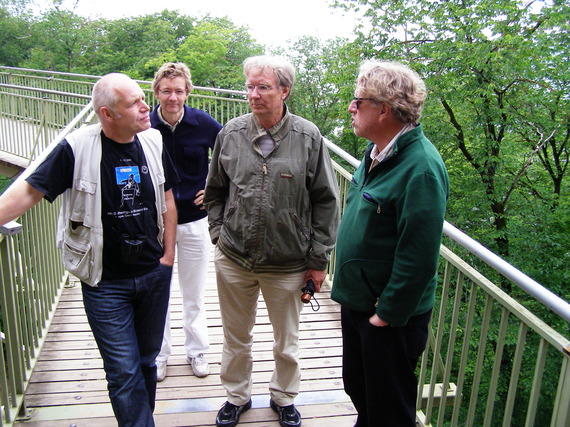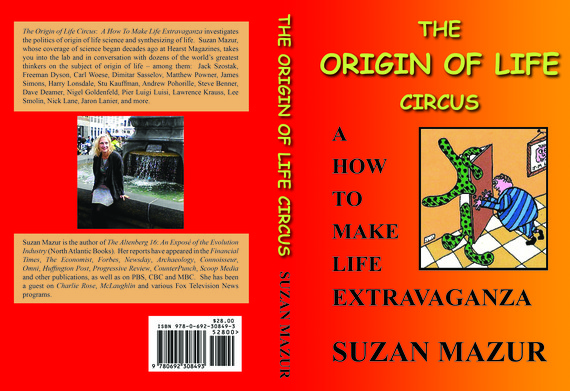Founders of the Copenhagen-Tartu School of Biosemiotics at a Seminar in Estonia: (l-r) Kalevi Kull, Claus Emmeche, Jesper Hoffmeyer, Frederik Stjernfelt
With Internet content increasingly about video, about meaningful signaling - i.e., semiosis -- I thought it might be time to ring up Kalevi Kull, a theoretical biologist in Estonia at the University of Tartu's Institute of Philosophy and Semiotics to talk about developments. Kull is known for his contributions to the field of biosemiotics and currently serves as president of the International Society for Biosemiotic Studies. His most recent book is Towards a Semiotic Biology: Life is the Action of Signs. Our conversation follows.
Kalevi Kull:
What's going on with biology now with an epigenetic turn or semiotic turn is similar to what happened 200 years ago when preformist biology was changed into epigenetic largely due to the work done by Karl Ernst von Baer, who established embryology and developmental biology. The epigenetic dominance in biology lasted then until the Modern Synthesis of the 1930s, which meant the beginning of the period of genetic preformism as a dominant view. Now we face the turn to an epigenetic view again, endowed by a much deeper understanding of what life is.
Life is semiosis. From this definition for life, by the way, it follows that life is the inheritance of the capacity to search, interpret and choose, together with an inheritance of constraints or scaffolding that results from earlier practice.
This is a really big change, and this discussion around the Modern Synthesis is just a part of it -- but of course, a big, important part.
Suzan Mazur: Science in Europe seems a bit more philosophical than in the US.
Kalevi Kull: The scaffolding for academic knowledge and creativity is a building in which history matters. The diversity of neighboring scholarly cultures as we have it in Europe may indeed play a role. Anyhow, each country has its specifics in its school of thought. We can observe that continental Europe has traditionally put more emphasis on holism, while Anglo-American thought has stressed competition; from Latin America we have the concept of autopoiesis, which is fairly different from both. . . .
Suzan Mazur: In biosemiotics you're looking at the process of signaling and how organisms make themselves by signaling.
Kalevi Kull:
Well it's more than just signaling. It is meaning-making. It is about meaningful communication and that leads to how organisms of other species themselves see the world, how they model the world. That part of biology you cannot learn much from a textbook.
Suzan Mazur: Did you once say evolution is essentially whatever happens happens or was that Stan Salthe?
Kalevi Kull:
My perspective is that we do not need evolution in order to survive -- for living itself, evolution is not necessary. For living itself, we can usually do it without any evolution. The rearrangements the living systems make while conditions change are made during their lifetime, otherwise they wouldn't survive. Even a couple of generations is not a long time for evolution -- evolution is a slow process. But organisms cannot avoid evolution, it just happens. They cannot avoid that some changes that they make become irreversible. We not only cannot avoid evolution, by living we influence it.
Suzan Mazur: Is biosemiotics an exact enough science at this point to be poking holes in the Modern Synthesis? Are the operational concepts developed enough?
Kalevi Kull: I would say they are developed as much as linguistics can be called scientific. Once you accept linguistics as a science that with operational concepts studies verbal modeling and communication in humans, then when we speak about umwelt and sign communication in other species -- yes, we can study it scientifically. We are dealing not with universal laws but with rules and habits that life itself has established locally. This means an emphasis on behavior, communication, learning, creativity.
Suzan Mazur: How do organisms remember these ancient signals?
Kalevi Kull: There's not much difference between the inheritance of the capacity to learn or the inheritance of cellular signaling. We know how it goes. So, the inheritance of the capacity to communicate -- there's nothing special here if we accept that not everything is in genes. . . .
Suzan Mazur: Biosemiosis was derived from the Russian word biosemiotika. How active are Russian scientists currently in this area of investigation?
Kalevi Kull: Well, cultures use different languages, they live with different habits, and so do, in a certain extent, also the academic cultures. You cannot measure knowledge or understanding, these are qualitative phenomena. Estonia is situated between Russia and Western Europe -- friends in both sides. Thus it may be that it is easier here to understand these different cultures. The term biosemiotics seems to have been coined independently in a couple of places.
Suzan Mazur: Estonia was part of the Former Soviet Union.
Kalevi Kull: Right. This was not a good experience, though our experience is richer due to that. These different views, therefore, come to us. Estonia is a good place for making new syntheses. But when it comes to biosemiotics, American scientific work is important to us as well. Thomas Sebeok's work at Bloomington, for example. And also Baltic-German and German biology, including the work of Jakob von Uexküll -- one of the pioneers of theoretical biology, who in 1920 wrote one of the very first monographs on theoretical biology, completely developing the semiotic view. Uexküll was from our university, Tartu. And we shouldn't forget the Tartu-Moscow school of semiotics.
Suzan Mazur: So biosemiotics started there, in your part of the world.
Kalevi Kull: Each idea comes from earlier ideas. Maybe in Europe you just find a bit more of this kind of thinking -- in Denmark, Czechia, Estonia.
Suzan Mazur: How far along would you say is understanding the role of biosemiotics, of signaling regarding protein synthesis? Denis Noble, for example, has written that the so-called DNA code terminology needs to be toned down because the process is actually more a matter of communication from within the cell to the otherwise inert DNA. Noble says the causality is circular.
Kalevi Kull: I agree very much with Denis Noble's approach on this. The emphasis should be on the communicative -- which means, semiotic -- aspects of biological processes.
Suzan Mazur: Fermilab is now investigating whether we live in a 2D world, a hologram. What are your thoughts? How might semiotics factor in here?
Kalevi Kull: These studies in Fermilab are not about life. Erwin Schrödinger was probably right when concluding that quantum physics will not provide much for understanding life. However, semiotics via its fundamental contribution to epistemology might be helpful in understanding the relationships between the models and the modeled, including in quantum physics.
Different organisms live in different worlds in that sense because they create different models in their minds. Likewise, umwelt changes a lot during the ontogenesis; a baby's world is fairly different from the one of an adult. For some organisms, there is no model of space at all. So in that sense it depends on species and on the stage in life cycle; and of course, our consciousness together with its language faculty adds something. This is related to the types of signs organisms can use. Only humans can use symbols, it is the basis of our spatial-temporal world -- which I would say is even multi-dimensional. . . .


